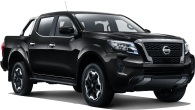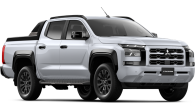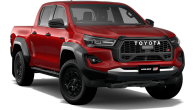Australians have long been known for their love of the work ute, and the humble HiLux has long been their clear favourite. The ute tradition began way back in time when farmers and tradies hacked the back off passenger cars and tacked on an often roughly hewn ute body to fashion their own work vehicle.
Smart car men soon caught on to the idea and began to produce utes themselves. They were an instant hit, but in more recent times it's the imported one-tonne utes from Asia that have come to dominate our market.
The HiLux is the leader of the pack and is now one of the top selling vehicles of any sort as Australians snap them up for all manner of jobs, both personal and professional.
MODEL WATCH
The HiLux line dates back to the 1970s when Toyota began importing them to compete against the locally built Holden and Ford utes. Those early models were rough, but ready to work. They had few frills, but they could carry a decent load and were more affordable than the local models.
It wasn't long before the locals were struggling against the might of the Asia tidal wave, and for part of the 1980s Holden actually stopped making commercials while it regrouped for another attack. The latest HiLux hit the job site in 1985 and it was a far cry from the rough and rugged ute that first landed here almost 40 years ago.
Today's HiLux has to perform a number of duties, not all of them work related. Some models are still aimed at the tradie or farmer, but the range now extends to some pretty well equipped, relatively refined models that never see the work site.
It's the growth of those fun time models, mostly 4WD dual-cabs, that has been largely responsible for the recent surge in HiLux sales that has seen it even top the monthly sales charts a couple of times.
The 2005 model was the first since 1997 and boasted a total of 30 variants, with two and four-wheel drives, utes and cab-chassis, single cabs, extended Xtra cabs and double cabs, petrol and diesel engines, and three levels of equipment. It was a comprehensive range that covered a multitude of demands from a diverse buying group.
All models in the new range were larger than the outgoing ones with a longer wheelbase with wider track front and rear. They were also roomier inside and boasted a longer load area.
Three engines were offered. There was a 2.7-litre double overhead camshaft four-cylinder with variable valve timing that put out 118 kW at 5200 revs and 241 Nm at 3800 revs, a new double overhead camshaft 4.0-litre V6 that delivered 175 kW at 5200 revs and 376 Nm at 3800 revs, and a 3.0-litre common rail turbo diesel that produced 120 kW at 3400 revs and 343 Nm from 1400 to 3300 revs.
There was a choice of a standard five-speed manual gearbox, and optional four or five-speed autos. It was also possible to choose two or four-wheel drive, the latter a part-time system boasting high and low range four-wheel drive.
The HiLux suspension was a rugged combination of double wishbones with coil springs at the front and longer leaf springs at the rear. Toyota also equipped the HiLux with larger brakes, and made ABS braking standard on the range-topping SR5 model and optional across the rest of the range.
The range began with the working class 4x2 Workmate chassis-cab, which was only available with the 2.7-litre four, and climbed through the SR, which made up the bulk of the range with V6 petrol or 3.0-litre diesel and all three cabs, and finished with the SR5, which was available with the V6 petrol and the diesel engine and two or four-wheel drive, but only as a dual cab.
The SR5 came with the lot to appeal to those who wanted their ute mainly for the weekend. All SR5 models had alloy wheels, body coloured bumpers and grilles, a polished sports bar, chrome touches, power windows and mirrors, air, leather steering wheel, trip computer, MP3 compatible sound with six-stacker CD, cloth trim and carpets.
IN THE SHOP
The HiLux was marketed as 'unbreakable' and is generally reliable and rugged. The engines are sound, the transmissions appear to give little trouble, and the chassis is tough as nails. If there is a fault it can be the clutch, which is marginal when towing. Owners have complained to Cars Guide about having to replace clutches as low as 80,000 km.
IN A CRASH
Toyota put more effort into safety with the 2005 HiLux with a stronger body and chassis, and improved crush zones to better absorb a frontal impact. All models had dual front airbags with seat belt pretensioners. ABS brakes were standard on the high range SR5 model and optional on the rest of the range.
UNDER THE PUMP
Toyota claimed fuel economy improvements across the HiLux range. The base model Work Mate 4x2 four gave 11.2 L/100 km, the 4x2 diesel was 16 per cent better than the old model with 8.2 L/100 km a typical return, and the 4x4 V6 petrol was put at 13 L/100 km. Many owners who bought the V6 petrol engine found they had a bit of a gas guzzler on their hands; diesel is the better choice.
LOOK FOR
* Renowned reliability
* diesel economy
* thirsty V6
* clutch marginal for towing
* Capable on and off road.
THE BOTTOM LINE
* Tough and reliable the HiLux covers all bases with a model to suit all needs.
RATING
80/100
Toyota Hilux 2005: (4X4)
| Engine Type | Diesel Turbo 4, 3.0L |
|---|---|
| Fuel Type | Diesel |
| Fuel Efficiency | 0.0L/100km (combined) |
| Seating | 2 |
| Price From | $6,600 - $9,350 |
Pricing Guides









.jpg)

.jpg)








